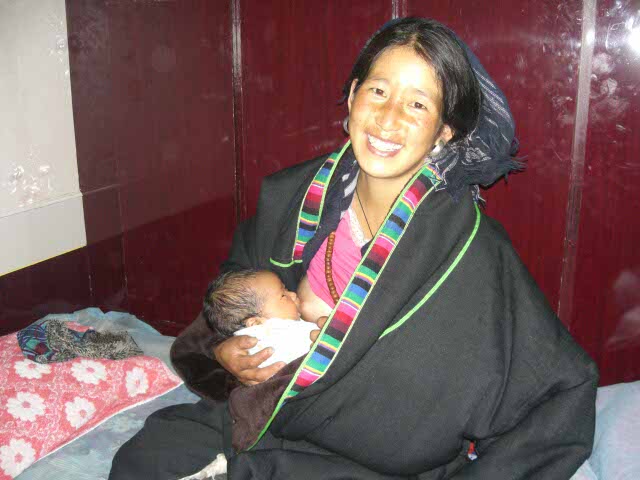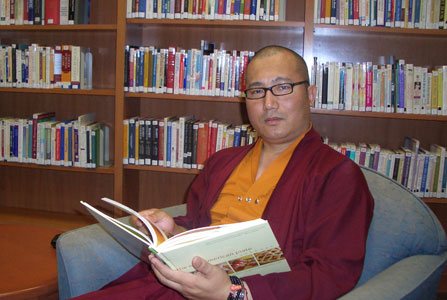Among the most poor and vulnerable in the world are the women and children who live without access to basic healthcare and hygiene, potable water and adequate nutrition.
In a remote corner of the world, one man is making a difference.
Dr. Kunchok Gyaltsen, founder of The Tibetan Healing Fund, has decided that saving women and children is the key to a healthy future for his people. He is a man with a burning mission. 
Imagine a woman laboring alone and giving birth by herself in a tent in a remote village. There is no one to help and medical care is far away. It is winter, there is no electricity, no heat, no soap, no running water and food is scarce. What will she do if she cannot stop bleeding? If her newborn is not breathing? What will happen if infection sets in for mother or baby? Within minutes or days, both may be dead.
Every day poor and malnourished women risk their lives in childbirth. Risk of death is high for both mother and newborn in the first few days of life. Life-threatening complications at birth require rapid response. Postpartum bleeding can kill a mother in a few hours, and a newborn who is not breathing at birth will be dead within minutes.
Arlene Samen, Nurse Midwife and Executive Director of One Heart WorldWide
"The Tibetan society is one of the few in the world where there is no tradition of trained birth attendants. Poor nutrition, lack of trained health personnel, long travel distances, and limited access to emergency care place Tibetan women and infants at high risk of birth-related deaths. The vast majority of births take place at high altitude, in a cold environment, and without access to electricity or health care. More than 95% of Tibetan women give birth at home. Most babies are delivered with the help only of the mother or the mother-in-law whose sole assistance is the cutting of the cord. Amazingly, many Tibetan women deliver their babies completely on their own. "
According to the World Health Organization, the vast majority of maternal and child deaths are preventable, but unacceptably large numbers of women, newborns and children are still dying each year. Ninety five percent of these deaths occur in the world's poorest areas. A growing proportion of child deaths occur in the first four weeks of life. Poorly functioning health infrastructure, inadequate numbers of health workers, slow adoption of evidence-based health policies and insufficient focus on quality of care are holding back progress in many countries. Skilled care at birth, including emergency care for mothers and newborns, is critical.
•Approximately 2 million lives a year are lost to complications occurring during labor and childbirth.
•Pneumonia and diarrhea remain the largest killers of children after the newborn period.
•Under-nutrition contributes to more than one third of child deaths
Now entering their 10th year, Dr. Kunchok and the Tibetan Healing Fund continue their determination to change these statistics.
Dr. Kunchok was born on the great Tibetan Plateau, in Amdo Province, now known as Qinghai Province, in the Peoples Republic of China, during the demise of the devastating Cultural Revolution. These were times of great poverty and lack of access to education. Life was harsh. Opportunities were few. Young Kunchok decided to enter monastic life and engaged in rigorous traditional training at the famous Kumbum Monastery. During this period he also achieved a doctorate in Tibetan Medicine.
Hungry for more knowledge he decided to apply to universities in the United States. In spite of having only monastic education, he was accepted to the the School for International Training in Vermont on a full scholarship. His academic excellence and achievements eventually led him to the prestigious School of Public Health, at University of California at Los Angeles (UCLA) where has earned his doctorate in Public Health.
As a Tibetan Buddhist monk, he upholds a high standard of ethics and values including a commitment to live a compassionate and altruistic life that is dedicated to relieving the suffering of others. In fact, he says that the principles and philosophies of Public Health are completely in alignment with his spiritual commitment to work for the common good of all people. With energy and enthusiasm he exclaims "I love Public Health!"
While studying in the United States he founded the Tibetan Healing Fund in 2001. Tibetan Healing Fund (THF) is a not-for-profit humanitarian organization established to improve primary healthcare and education for rural Tibetan women and children in the Tibetan regions of P.R. China. THF's priority is to assist the most disadvantaged Tibetan communities, which lack or have limited access to health care, education and technical skills and training.
Dr. Kunchok has done extensive research into the plight of women and children of the Tibetan Plateau. He has managed to open a model Maternal and Child Health complex that has already delivered 150 babies in its first year. Several high risk births have been managed safely and all of the mothers and babies are doing well. The Tibetan Natural Birth and Health Training Center (Birth Center), is a complex that includes basic healthcare services along with a place for safe birthing care and classes in nutrition and hygiene. There is even a vegetable garden and a residential facility for the families.
Dr. Kunchok is training an army of both professional and lay Tibetan women health care providers and birth specialists to serve the needs of Tibetan women who are reluctant to go to male doctors or to hospitals. Designing a culturally sensitive environment in which Tibetan women are comfortable receiving care has been important to the success of this project. Dr. Kunchok, in spite of being a monk, is as sweetly delighted as any proud father...150 times over!
In August 2010, Dr. Kunchok will go home armed with new skills and knowledge, including a doctorate in Public Health and Primary Health Care Management and a Masters Degree in International and Intercultural Management. He will resume his teaching post at Tso-Ngon (Qinghai) University Tibetan Medical College and his administrative responsibilities as Executive Director of Kumbum Tibetan Medical Hospital, currently the largest facility of its kind; reputed for its quality care, professionalism, and pharmaceutical expertise. And he says he has just begun!
Over the years Dr. Kunchok has invited Public Health experts to visit and teach his colleagues in China. And he hopes that Tibetan health care workers will travel to the United States to observe our health care and public health systems to receive advanced training. He believes that when two cultures and two medical systems meet and share, both can benefit each other. He envisions a synthesis of modern BioMedicine with the healing arts of Tibetan Medicine.
He has big plans. Here is what is on the agenda of the Tibetan Healing Fund:
Health and Education Projects
•Continue to expand and develop services available at the Tibetan Natural Birth and Health Training Center and Birth Center which opened in 2009 and has served over 2000 Tibetan women. (There are currently no services available for very high risk births or surgeries. Women must travel by ambulance to another location at this time.)
• Continue to Train Community Midwives who serve remote areas and educate the community in basic care and encourage women to come to the Birth Center for safer labor and delivery and recovery (20 community midwives have been trained)
•Community Health Education and Outreach: Teaching communities through the development of educational materials including traveling theater for those who do not read and write along with dvds and printed materials in Tibetan. (50 Tibetan Medical Students have provided services to 3000 Tibetans in remote areas, over 12,000 Tibetan women have received healthcare education)
•Scholarships for Postgraduate and Medical School for Tibetan women
•Tibetan Maternal and Child Health System Resource Textbooks
•Community Health Assessment: continue to do research and gather data in order to be able to secure funding and develop appropriate programs
•Teacher training and improved access to quality education as a way to enhance the livelihood of individuals and the community.
•Visiting Scholars exchange program.
•Training of Trainers (extending healthcare services into the community)
•Children's Fund
•Tibetan Heritage Primer Textbooks (9000 textbooks have been published)
•Teacher Training (over 550 teachers have been trained)
•Improve Access to Quality Education and School Improvement Projects (300 children have completed primary education)
What do donations fund? $50 allows a Tibetan student to read a textbook in her own language. $160 provides a medical kit for community midwives. $350 provides midwife training and $1000 sends Tibetan medical students to provide health care and education in remote areas. $90,000 builds a new Birth and Training Center.
Dr. Kunchok's efforts have now expanded beyond Qinghai province to other Tibetan regions including Kham and U-Stang (today known as Gansu, Sichuan and Yunnan Provinces ) as well as the Tibetan Autonomous Region. These are the areas of the Peoples Republic of China where there are significant numbers of medically under-served Tibetan people.
Dr. Kunchok's dedication and genius is an example of the extraordinary humanitarian effort of one inspired and capable human being. His project can serve as a model that can be replicated and implemented in regions all over the world where there are similar medically under-served vulnerable populations, especially in areas where there are high rates of maternal and infant deaths.

Dr. Kunchok Gyaltsen is in a unique position to not only serve the people of the Tibetan Plateau through the Tibetan Healing Fund, but also to serve as a model and an inspiration to all of us. If you have ever wondered if just one person can make a difference, here is a shining example.
How can you help? Donate to the Tibetan Healing Fund. Go out and make difference to someone in your community today.
References:
Tibetan Healing Fund: http://www.tibetanhealingfund.org
Private Interviews with Dr. Kunchok Gyaltsen
One Heart WorldWide http://www.oneheartworld-wide.org/